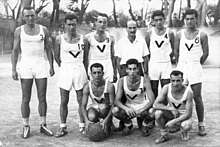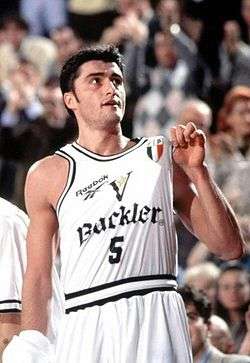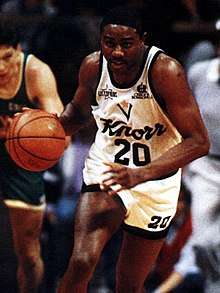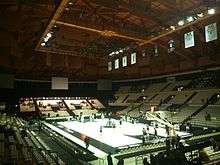Virtus Pallacanestro Bologna
| Virtus Pallacanestro Bologna | |||
|---|---|---|---|
 | |||
| Nickname |
Vu Nere Black V | ||
| Leagues |
LBA Champions League | ||
| Founded | 1929 | ||
| History |
Virtus Bologna 1929–present | ||
| Arena |
Unipol Arena PalaDozza | ||
| Capacity |
Unipol Arena – 9,513 PalaDozza – 5,570 | ||
| Location | Bologna, Italy | ||
| Team colors |
White, black | ||
| Main sponsor | Segafredo Zanetti | ||
| President | Alberto Bucci | ||
| Head coach | Stefano Sacripanti | ||
| Team captain | Brian Qvale | ||
| Ownership | Massimo Zanetti[1] | ||
| Championships |
15 Italian Championships 8 Italian Cups 2 Euroleagues 1 Saporta Cup 1 EuroChallenge 1 Italian Supercup 1 Italian LNP Cup 1 Serie A2 Basket | ||
| Retired numbers | 3 (4, 5, 10) | ||
| Website | virtus.it | ||
| Uniforms | |||
|
| |||
Virtus Pallacanestro Bologna, known for sponsorship reasons as Virtus Segafredo Bologna,[2] is an Italian professional basketball club based in Bologna, Emilia-Romagna. The Club was founded in 1929, which makes it the oldest club in the Lega Basket Serie A, and it is the second most titled basketball club in Italy after Olimpia Milano, having won 15 Italian League championships, 8 Italian National Cups and 1 Italian Supercup. It currently plays in the Italian first division LBA.
For past club sponsorship names, see the list below.
History
Beginnings and first championships
Virtus was founded in 1871 as a gymnastics club, forming its first professional basketball team in 1929 as part of a multi sports club. The team's home court was the former church of Santa Lucia in the city center. The first official championship of Virtus dates back to 1934, the year in which the Bolognese team won the first division tournament, obtaining the promotion in the top tournament after a hard-fought group of play-offs against Unione Sportiva of Milan and Ginnastica Rome. After the promotion, Virtus settled permanently at the top of the national basketball league, and achieved a long series of honorable placings: in the nine championships disputed from 1935 to the outbreak of the Second World War, the Black V collected 6 second places, 2 third places and a sixth place.

At the end of the world war, the Santa Lucia was no longer available for basketball games and after a brief period of outdoor matches on a field in Via del Ravone, the team moved to Sala Borsa, the city's stock exchange, readjusted in the evening for basketball matches. This unusual venue became the hallmark of a new Italian basketball season, compared to the worldwide famous Boston Garden. Right here in 1945, Virtus, led by Achille Canna, Luigi Rapini and Antonio Calebotta, won its first national Serie A title, adding the next three editions as well. The Black V won the national title again in 1955 and 1956, achieving a so-called "back-to-back". During the 1950s the long-time rivalry with Olimpia Milano began, as also the first derbies with Gira and Moto Morini.
Due to the increasingly fame of Virtus, the Sala Borsa was no longer suitable for hosting games; so in 1956, the long-time Mayor of Bologna, Giuseppe Dozza, inaugurated a new arena, which was simply known as "Sports Hall" and had a seating capacity of more than 7,000 people.[3] The arena was later nicknamed Il Madison, after New York's Madison Square Garden and, in 1966, after Dozza's retirement from politics, it was re-named "PalaDozza".
During 1960s and 1970s
The 1960s have been an unfortunate decade for Virtus. The Bolognese team did not win any national title and the Italian basketball was dominated by its historic rivals, Olimpia Milano and Ignis Varese. The turning point came from 1968, when the lawyer Gianluigi Porelli was appointed by the then president of the multi-sport club, Elkan, at the head of the basketball section. Alternately nicknamed "Torquemada" or "Robespierre" for his quick and often dictatorial methods, or, more frequently, L'Avvocato ("The Lawyer"), Porelli has been one of the most prominent figures in the history of Virtus, which through initiatives often unpopular but almost always winning, definitively ferried towards professionalism.
As soon as he arrived, at only 38 years old, Porelli cleaned up the old managers and sold the best player of the time, Gianfranco Lombardi, unleashing a popular uprising that even ended up in court. Soon after, in 1970, Virtus broke away from the multi sports club and became a joint-stock company. Thanks to this choice, which was highly criticized, Porelli definitively healed the finances and in 1973 opened a new season of triumphs, thanks to a partnership with Sinudyne, a famous Italian domestic appliances company, and especially with the engagement of the young American coach Dan Peterson, coming from the Chile's national basketball team. Virtus immediately won its first Italian Cup in 1973/74 and, after two years, its seventh national championship, thanks to the leadership of players like Terry Driscoll, Carlo Caglieris, Gianni Bertolotti, Marco Bonamico and Luigi Serafini. In 1978 coach Peterson moved to Olimpia Milano and the former player Terry Driscoll was appointed new head coach. Under him, Virtus won two consecutive national titles in 1979 and 1980.[4] The most important players of that back-to-back were Renato Villalta, Jim McMillian, and Krešimir Ćosić.
Through 1980s
Returning to the top in Italy, the Black V attempted to become a major team in Europe too, and in 1981 they reached the final of the Champions Cup in Strasbourg. However they lost by only one point against Maccabi Tel Aviv, after a very contested game and dubious referee's choices. After the defeat in the Cup, Driscoll retired as coach and Porelli hired Aleksandar Nikolić, worldwide known as "The Professor". The team was composed also by young and talented Italians like Roberto Brunamonti and Augusto Binelli. Despite his fame, Nikolić did not succeed in brining Virtus back to title, so in 1983, Alberto Bucci, a 35 years-old man from Bologna, became the new head coach. Under Bucci, Virtus won its tenth national championship, defeating Peterson's Olimpia in a historic final, always remembered as one of the best in Italian basketball history. In the same year, the team completed a domestic double by adding a National Cup.[5]
In 1988, Porelli hired Bob Hill, who was New York Knicks' head coach until the previous season. Hill brought in Italy two former NBA players: Micheal Ray Richardson, a NBA All-Star and former player for NY Knicks and New Jersey Nets, who was banned from the NBA for violations of the league's drug policy, and Clemon Johnson, 1983 NBA champion with the Philadelphia 76ers, who notable played also for Indiana Pacers and Seattle SuperSonics. In 1988/89 Virtus won its third Italian Cup but it was defeated in the semi-final for the national championship.
In the following summer, Hill resigned from his post, and his assistant, the 30 years-old Ettore Messina, was appointed new head coach. The Black V won the Italian Cup again and on 13 March 1990 won its first European title, the Cup Winners' Cup, the second-tier level European-wide competition, defeating the Real Madrid coached by George Karl. The final was characterized by an outstanding performance of Richardson, capable of scoring 29 points.
The Golden Age of 1990s

In 1991, Alfredo Cazzola, a local trade fair entrepreneur, became the new president of Virtus. After two consecutive defeats in national semi-finals, Cazzola hired Predrag Danilović, a young Yugoslav player who won the latest Champions Cup with Partizan Belgrade. Under the strong leadership of Danilović, the team immediately won another national championship with Ettore Messina as head coach. However, on the following year, Messina became the new coach of Italy's national basketball team and Alberto Bucci, returned to coach Virtus, with whom he had won a national champion in 1984. Virtus won the scudetto again in 1994 and 1995, accomplishing a three-peat. In the same years, the team took part in the McDonald's Championship, an international cup competition between NBA and European teams, where Virtus was slightly defeated by Phoenix Suns Houston Rockets.
After the three-peat, Danilović left Virtus for the Miami Heat and without its Yugoslav leader, the Bolognese team won only an Italian Supercup for 1995/96 and its fifth Italian Cup on the following year. In 1997, Virtus moved to PalaMalaguti, an indoor sporting arena in Casalecchio di Reno with a seating capacity of more than 8,000 people, leaving PalaDozza after almost 40 years. In the same year, with the return of Messina and Danilović, the team was completed with important international players like Zoran Savić, Radoslav Nesterovič, Antoine Rigaudeau, Hugo Sconochini, Alessandro Frosini and Alessandro Abbio. On 23 April 1998, Virtus won its first EuroLeague, defeating AEK Athens in Barcelona.[5] While on 31 May, Virtus conquered its 14th national title, defeating in Game 5 of the final, Fortitudo Bologna. At twenty seconds from the end of the game, with Fortitudo leading by 4, Danilović scored a three-points shot and at the same time suffered a foul by Dominique Wilkins, completing the so-called “four-point shot”. Than Virtus would won the match in the over time. The 1998 final between Virtus and Fortiudo is widely considered as the greatest one in the history of Italian basketball, with two teams from the same city, which were among the best ones in the continent.[6] During this period, Bologna was nicknamed "Basket City", due to the fame and the wins of town's two teams.[7]
In the following season, Virtus won its 7th Italian Cup but lost in the EuroLeague final against Zalgiris Kaunas of Tyus Edney and was eliminated in the semi-finals for the national championship. Under Cazzola's presidency and thanks to the leaderships of Danilović and coach Messina, the 1990s were considered the "Golden Age" of Virtus, which collected four national titles, two Italian Cups, a Cup Winners' Cup and a EuroLeague, becoming one the most notable and successful team in Europe.
Glory, relegation and rebirth through 2000s
In 2000, Marco Madrigali, a video game entrepreneur, became the new president. New players, like Marko Jarić, Manu Ginóbili, Matjaž Smodiš, Rashard Griffith and David Andersen arrived in Bologna; while at the beginning of the season, Sasha Danilović suddenly announced his retirement from basketball. The absence of an emotionally leader like Danilović and the subsequent ban for doping of another historic player like Hugo Sconochini, forced every single player of the team to take more responsibility, but at the same time opens spaces to the immature and talented newcomers, free to show their abilities and experience at a high level. After a though beginning, the season had a turning point during the Christmas derby against Fortitudo, which was soundly won by the Balck V by 99–62. From then, Virtus started an outstanding season, characterized by an unrepeatable group capable of beating every record and becoming one of the strongest European teams of all time and, according to many, the strongest ever.[8][9] After the double in 1998, in 2000/01 season, Virtus completed a Triple Crown (known in Italy as Grande Slam), winning the Italian Cup, the EuroLeague against Tau Vitoria and a national title, beating Fortitudo 3–0.[5][10] Manu Ginóbili was named the 2001 Euroleague Finals MVP and Italian League MVP.[11]
On the following year, Virtus won the Italian Cup, but after some defeats Madrigali fired Messina. However, after a peaceful field invasion by Virtus supporters before a match against Pallacanestro Trieste, Madrigali was forced to re-hire him. However, the team lost the EuroLeague final, which were held in PalaMalaguti, against the Panathinaikos B.C. of Dejan Bodiroga, and was eliminated in the semi-finals for the national championship by the Benetton Treviso.
In 2003, Ginóbili moved to the NBA, where he played for the San Antonio Spurs, and Ettore Messina was hired by Benetton, thus Bogdan Tanjević was appointed new head coach. After a soundly defeat in Fabriano, Tanjević was replaced by Valerio Bianchini, who failed in reaching the play-offs (for the first time in Virtus history) but succeeded in saving the team from relegation. Suffering from serious financial problems, mainly caused by the failure of Madrigali's video game company, Virtus was excluded from the Serie A in August 2003, after missing payments to players, first of all the young Slovenian Sani Bečirovič.[5][12][13] The bankruptcy was avoided thanks to the intervention of a local trade fair entrepreneur, Claudio Sabatini, who transacted all the debts of the team, after agreements with creditors and took over the company from Madrigali. Sabatini acquired also the team Progresso Castelmaggiore, from a small town in Bologna's hinterland, which played in Serie A2 and sponsored the new team with FuturVirtus brand, guaranteeing therefore the continuity of the glorious name "Virtus" despite the exclusion from the championships. In 2003/04, FuturVirtus did not reach the promotion in Serie A, losting 3–0 in the final series of playoffs from Aurora Jesi. However, during the summer 2004 he obtained the re-affiliation to the Italian Basketball Federation and the right to use the name "Virtus Pallacanestro" again. The Black V, led by Corey Brewer and A.J. Guyton, returned to the top division in 2004, defeating 3–0 the Premiata Montegranaro.
In 2006-07 they qualified for the playoffs after a five-year absence, reaching the championship finals but losing to Montepaschi Siena. They also reached the EuroCup semifinals.[5]
In 2009 they added another trophy to their cabinet, with the European third tier EuroChallenge, with 21 points from Finals MVP Keith Langford in the final against Cholet Basket.[14]
On 4 May 2016 Virtus was relegated to Serie A2 Basket for the first time in its history after finishing in the last position of the 2015–16 Lega Basket Serie A.[15]
Arena
Since its foundation, Virtus Bologna has changed several home arenas. Each of them was more than just a basketball court, rather a real "house" of the Black V, marking, in the period when they were used, a different era of the long history of society:
- 1934-1946: Church of Santa Lucia (today it is the auditoriom of the University of Bologna).
- 1946: Court Via Ravone.
- 1946-1957: Sala Borsa (today Biblioteca Salaborsa).
- 1957-1996: PalaDozza
- 1996-2017: PalaMalaguti (since 2008 Futurshow Station, since 2011 Unipol Arena), in Casalecchio di Reno.
- 2017- : PalaDozza and Unipol Arena.
Honours
Total titles: 28
Domestic competitions
- Winners (15): 1945–46, 1946–47, 1947–48, 1948–49, 1954–55, 1955–56, 1975–76, 1978–79, 1979–80, 1983–84, 1992–93, 1993–94, 1994–95, 1997–98, 2000–01
- Runners-up (16): 1935–36, 1937–38, 1939–40, 1942–43, 1949–50, 1951–52, 1952–53, 1956–57, 1957–58, 1958–59, 1959–60, 1960–61, 1976–77, 1977–78, 1980–81, 2006–07
- Winners (8): 1973–74, 1983–84, 1988–89, 1989–90, 1996–97, 1998–99, 2000–01, 2001–02
- Runners-up (6): 1992–93, 1999–00, 2006–07, 2007–08, 2008–09, 2009–10
- Winners (1): 1995
- Runners-up (7): 1997, 1998, 1999, 2000, 2002, 2009, 2010
- Winners (1): 2017
- Winners (1): 2016–17
European competitions
- Winners (2): 1997–98, 2000–01
- Runners-up (3): 1980–81, 1998–99, 2001–02
- 4th place (1): 1979–80
- Final Four (3): 1998, 1999, 2002
- Winners (1): 2008–09
Worldwide competitions
Unofficial
- Winners (1): 2000–01
Season by season
| Season | Tier | League | Pos. | W–L | Italian Cup | Other competitions | European competitions | |||
|---|---|---|---|---|---|---|---|---|---|---|
| 2007–08 | 1 | Serie A | 15th | Runners-up | 1 Euroleague | |||||
| 2008–09 | 1 | Serie A | 5th | Runners-up | 3 EuroChallenge | |||||
| 2009–10 | 1 | Serie A | 5th | Runners-up | ||||||
| 2010–11 | 1 | Serie A | 8th | |||||||
| 2011–12 | 1 | Serie A | 5th | |||||||
| 2012–13 | 1 | Serie A | 14th | |||||||
| 2013–14 | 1 | Serie A | 13th | |||||||
| 2014–15 | 1 | Serie A | 8th | |||||||
| 2015–16 | 1 | Serie A | 16th | |||||||
| 2016–17 | 2 | Serie A2 | 1st | LNP Cup | ||||||
| 2017–18 | 1 | LBA | 9th | Quarterfinalist | ||||||
| 2018–19 | 1 | LBA | 3 Champions League | |||||||
Top performances in European & Worldwide competitions
| Season | Achievement | Notes | |
|---|---|---|---|
| Euroleague | |||
| 1979-80 | Semi-final group stage | 4th place in a group with Maccabi Elite, Real Madrid, Bosna, Nashua EBBC and Partizan | |
| 1980-81 | Final | lost to Maccabi Elite 79-80 in the final (Strasbourg) | |
| 1984-85 | Semi-final group stage | 6th place in a group with Cibona, Real Madrid, Maccabi Elite, CSKA Moscow and Banco di Roma Virtus | |
| 1991-92 | Quarter-finals | eliminated 2-1 by Partizan, 65-78 (L) in Belgrade, 61-60 (W) and 65-69 (L) in Bologna | |
| 1992-93 | Quarter-finals | eliminated 2-0 by Real Madrid, 56-76 (L) in Bologna and 58-79 (L) in Madrid | |
| 1993-94 | Quarter-finals | eliminated 2-1 by Olympiacos, 77-64 (W) in Bologna, 69-89 (L) and 62-65 (L) in Piraeus | |
| 1994-95 | Quarter-finals | eliminated 2-1 by Panathinaikos, 85-68 (W) in Bologna, 55-63 (L) and 56-99 (L) in Athens | |
| 1997-98 | Champions | defeated Partizan 83-61 in the semi-final, defeated AEK 58-44 in the final of the Final Four in Barcelona | |
| 1998-99 | Final | defeated Teamsystem Bologna 62-57 in the semi-final, lost to Žalgiris 74-82 in the final (Munich) | |
| 2000-01 | Champions | defeated 3-2 Tau Cerámica, 65-78 (L) and 94-73 (W) in Bologna, 80-60 (W) and 79-96 (L) in Vitoria-Gasteiz, finally 82-74 (W) in Bologna | |
| 2001-02 | Final | defeated Benetton Treviso 90-82 in the semi-final, lost to Panathinaikos 83-89 in the final (Bologna) | |
| Saporta Cup | |||
| 1974-75 | Quarter-finals | 3rd place in a group with Spartak Leningrad, Jugoplastika and Moderne | |
| 1977-78 | Final | lost to Gabetti Cantù 82-84 in the final (Milan) | |
| 1978-79 | Semi-finals | eliminated by EBBC, 85-73 (W) in Bologna and 92-105 (L) in Den Bosch after two overtimes | |
| 1981-82 | Semi-finals | eliminated by Real Madrid, 78-79 (L) in Bologna and 94-107 (L) in Madrid | |
| 1989-90 | Champions | defeated Real Madrid 79-74 in the final of European Cup Winner's Cup in Florence | |
| 1990-91 | Quarter-finals | 3rd place in a group with Dynamo Moscow, Pitch Cholet and Ovarense | |
| 1999-00 | Final | lost to AEK 76-83 in the final (Lausanne) | |
| Korać Cup | |||
| 1975-76 | Semi-finals | eliminated by Jugoplastika, 83-74 (W) in Split and 79-92 (L) in Bologna | |
| EuroChallenge | |||
| 2006-07 | Final Four | 3rd place in Girona, lost to Azovmash 73-74 in the semi-final, defeated MMT Estudiantes 80-62 in the 3rd place game | |
| 2008-09 | Champions | defeated Proteas EKA AEL 83-69 in the semi-final, defeated Cholet 77-75 in the final of the Eurochallenge Final Four in Bologna | |
| McDonald's Championship | |||
| 1993 | Final | defeated Limoges 101-85 in the semi-final, lost to Phoenix Suns 90-112 in the final (Munich) | |
| 1995 | Final | defeated Real Madrid 102-96 in the semi-final, lost to Houston Rockets 112-126 in the final (London) | |
The road to the European Cup victories
|
1989–90 FIBA European Cup Winner's Cup
|
1997–98 FIBA Euroleague
|
2000–01 Euroleague
| ||||||||||||||||||||||||||||||||||||||||||||||||||||||||||||||||||||||||||||||||||||||||||||||||||||||||||||||||||
Players
Current roster
Note: Flags indicate national team eligibility at FIBA sanctioned events. Players may hold other non-FIBA nationality not displayed.
| Virtus Pallacanestro Bologna roster | |||||||||||||||||||||||||||||||||||||||||||||||||||||||||||||||||||||||||||||||||||||||||||||||||||||||||
|---|---|---|---|---|---|---|---|---|---|---|---|---|---|---|---|---|---|---|---|---|---|---|---|---|---|---|---|---|---|---|---|---|---|---|---|---|---|---|---|---|---|---|---|---|---|---|---|---|---|---|---|---|---|---|---|---|---|---|---|---|---|---|---|---|---|---|---|---|---|---|---|---|---|---|---|---|---|---|---|---|---|---|---|---|---|---|---|---|---|---|---|---|---|---|---|---|---|---|---|---|---|---|---|---|---|
| Players | Coaches | ||||||||||||||||||||||||||||||||||||||||||||||||||||||||||||||||||||||||||||||||||||||||||||||||||||||||
|
Updated: October 3, 2018 | ||||||||||||||||||||||||||||||||||||||||||||||||||||||||||||||||||||||||||||||||||||||||||||||||||||||||
Notable players
Retired numbers
- 4 –

- 5 –
.svg.png)
- 10 –

Other notable players
|
2010's
|
2000's
|
1990's
|
1980's
1970's
|
Head coaches


















.svg.png)




.svg.png)





















Sponsorship names
Throughout the years, due to sponsorship, the club has been known as :
- Minganti Bologna (1953–1958)
- Oransoda Bologna (1958–1960)
- Idrolitina Bologna (1960–1961)
- Virtus Bologna (1961–1962)
- Knorr Bologna (1962–1965)
- Candy Bologna (1965–1969)
- Virtus Bologna (1969–1970)
- Norda Bologna (1970–1974)
- Sinudyne Bologna (1974–1983)
- Granarolo Bologna (1983–1986)
- Dietor Bologna (1986–1988)
- Knorr Bologna (1988–1993)
- Buckler Beer Bologna (1993–1996)
- Kinder Bologna (1996-2002)
- Virtus Bologna (2002–2003)
- Carisbo Bologna (2003–2004)
- Caffè Maxim Bologna (2004–2005)
- VidiVici Bologna (2005–2007)
- La Fortezza Bologna [Domestically] (2007–2009)
- VidiVici Bologna [European competition] (2007–2008)
- Virtus BolognaFiere [European competition]) (2008–2009)
- Canadian Solar Bologna (2009–2012)
- SAIE3 Bologna (2012–2013)
- Oknoplast Bologna (2013)
- Granarolo Bologna (2013-2015)
- Obiettivo Lavoro Bologna (2015–2016)
- Segafredo Bologna (2016–present)
Kit manufacturer
References
- ↑ Majority Shareholder
- ↑ "Obiettivo Lavoro e Virtus: facciamo squadra insieme" [Obiettivo Lavora and Virtus: we form a team together]. Virtus Pallacanestro Bologna (in Italian). 18 June 2015. Retrieved 27 June 2015.
- ↑ Champions Cup 1965-66
- ↑ Il mito delle Vu Nere
- 1 2 3 4 5 "Virtus VidiVici - Club profile". Euroleague. Retrieved 27 June 2015.
- ↑ Basket, venti anni fa il tiro impossibile di Danilovic: e la Virtus beffò la Fortitudo
- ↑ Basket city, i migliori giocatori della storia della Virtus
- ↑ Le squadre più forti di sempre: la Virtus del Triplete di Messina
- ↑ Il Grande Slam della Virtus Kinder
- ↑ Virtus, Grande Slam. Lo Scudetto dopo l'Europa
- ↑ Manu Ginoboli Info Page – Bio Archived 24 May 2007 at the Wayback Machine., nba.com. Retrieved 17 June 2007.
- ↑ "Virtus Bologna is no more."La Gazzetta dello Sport, Roma, 4 August 2003. Retrieved on 3 June 2015.(in Italian)
- ↑ "Virtus is out, Messina retaken.", Messaggero Veneto – Giornale del Friuli via Lega Basket, 1 September 2003. Retrieved on 3 June 2015.(in Italian)
- ↑ "Virtus BolognaFiere beat brave Cholet". FIBA Europe. 26 April 2009. Retrieved 18 June 2015.
- ↑ "Virtus Bologna relegated for the first time". Eurohoops. 4 May 2016. Retrieved 5 May 2016.
- ↑ Virtus Segafredo-Ambalt Recanati, Virtus.it, Retrieved 23 March 2017.
External links
| Wikimedia Commons has media related to Virtus Pallacanestro Bologna. |
- Official website (in Italian)
- Historical record and names at Lega Basket Serie A Retrieved 27 June 2015 (in Italian)


